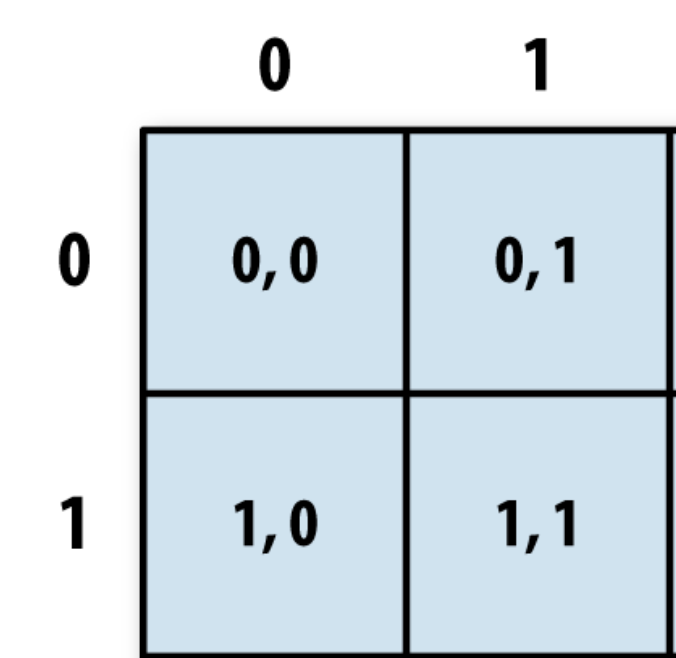I've read documentation several times about np.indices() but I can't seem to grasp what is it about. I've used it numerous times on things to see what it does, but I still can't really get it. Maybe the thing is I'm a beginner in programming so I can't understand the idea behind the words describing it. In addition I'm not a native English speaker (though I have no problems with it). I would be very grateful for kind of easier explanation, possibly on some example. Thanks.
Suppose you have a matrix M whose (i,j)-th element equals
M_ij = 2*i + 3*j
One way to define this matrix would be
i, j = np.indices((2,3))
M = 2*i + 3*j
which yields
array([[0, 3, 6],
[2, 5, 8]])
In other words, np.indices returns arrays which can be used as indices. The elements in i indicate the row index:
In [12]: i
Out[12]:
array([[0, 0, 0],
[1, 1, 1]])
The elements in j indicate the column index:
In [13]: j
Out[13]:
array([[0, 1, 2],
[0, 1, 2]])
The already posted answers are still complex so here is the simplest way to understand this.
Step 1: Let's create a 2x2 grid
ids = np.indices((2,2))
Step 2: Now let's unpack the i,j indices
i, j = ids
These are the indices i,j:
print(i)
[[0 0]
[1 1]]
print(j)
[[0 1]
[0 1]]
Step 3: Understand what i,j represent
The easy way to think of it is to make pairs as (i0,j0), (i1,j1), (i2,j2), (i3,j3) i.e. match each element of i with the corresponding element of j.
So we get: (0,0), (0,1), (1,0), (1,1).
These are exactly the indices of a 2x2 grid:
I've understood with this code.
The following function has the same behavior as np.indices().
# fixed dimensions=(2,3,4)
def my_indices():
dimensions = (2,3,4)
A = np.empty(dimensions)
# dimensions[0] = 2
A[0, :, :] = 0
A[1, :, :] = 1
B = np.empty(dimensions)
# dimensions[1] = 3
B[:, 0, :] = 0
B[:, 1, :] = 1
B[:, 2, :] = 2
C = np.empty(dimensions)
# dimensions[2] = 4
C[:, :, 0] = 0
C[:, :, 1] = 1
C[:, :, 2] = 2
C[:, :, 3] = 3
return [A, B, C]
Call
A, B, C = my_indices()
print(A.shape)
print(B.shape)
print(C.shape)
print('A\n', A)
print('B\n', B)
print('C\n', C)
RESULT
(2, 3, 4)
(2, 3, 4)
(2, 3, 4)
A
[[[0. 0. 0. 0.]
[0. 0. 0. 0.]
[0. 0. 0. 0.]]
[[1. 1. 1. 1.]
[1. 1. 1. 1.]
[1. 1. 1. 1.]]]
B
[[[0. 0. 0. 0.]
[1. 1. 1. 1.]
[2. 2. 2. 2.]]
[[0. 0. 0. 0.]
[1. 1. 1. 1.]
[2. 2. 2. 2.]]]
C
[[[0. 1. 2. 3.]
[0. 1. 2. 3.]
[0. 1. 2. 3.]]
[[0. 1. 2. 3.]
[0. 1. 2. 3.]
[0. 1. 2. 3.]]]
np.indices() use case
def create_hsv_map():
img_hsv = np.empty((180, 256, 3), np.uint8)
hue, saturation = np.indices((180,256))
img_hsv[:, :, 0] = hue
img_hsv[:, :, 1] = saturation
img_hsv[:, :, 2] = 255
# ...
example with np.repeat() instead of np.indices()
def create_hsv_map2():
img_hsv = np.empty((180, 256, 3), np.uint8)
hue = np.repeat(np.arange(180).reshape(180, 1), repeats=256, axis=1)
saturation = np.repeat(np.arange(256).reshape(1, 256), repeats=180, axis=0)
img_hsv[:, :, 0] = hue
img_hsv[:, :, 1] = saturation
img_hsv[:, :, 2] = 255
# ...
© 2022 - 2024 — McMap. All rights reserved.

